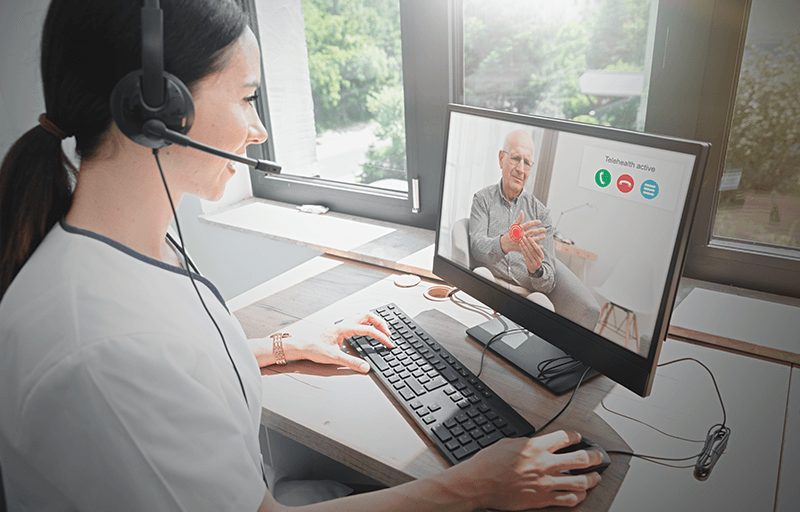Telehealth may seem like a brand-new way to get medical care, but it’s been successfully used around the world (and even in outer space) for decades.
Until recently telehealth – or telemedicine, which is often used interchangeably with telehealth – was primarily used in remote areas –isolated rural communities, research stations, military front lines and outer space – and required the use of expensive, powerful computer and communications systems. But as personal technology became more capable, telehealth became increasingly accessible to anyone. Now you can have virtual visits with a doctor using your phone, computer or smart device. But can telehealth really replace hands-on, in person healthcare?
The Advantages of Telehealth
In general, telehealth care is best used to address simple health issues such as:
- Allergies
- Bladder infections
- Bronchitis
- Ear infections
- Influenza
- Rashes
- Severe colds
- Sinus infections
- and similar ailments
A telehealth consultation can also help you determine if you need to see your own doctor or visit an urgent care clinic or emergency room.
Life-threatening issues, and anything that requires a physical examination or medical diagnostics testing are not best-suited for telehealth care. The exceptions would be if someone was in a situation that absolutely precludes access to an emergency room, urgent care clinic, or healthcare provider – e.g.: during a natural disaster, or living/working in an extremely remote area.
What Happens During a Virtual Visit with a Doctor?
Telehealth services designed for use by the public replicate the experience you’d have in a doctor’s office as closely as possible, minus many of the annoyances. There is no germ-filled waiting room, most visits happen within 10 minutes after you request the appointment, and the cost is typically significantly less than an in-person appointment (you can view average medical costs at sites such as Fairhealth Consumer)
Hands-on virtual exams are obviously not possible (yet!) but you can discuss symptoms via email, phone, computers, video chat, and/or dedicated applications/devices with a licensed health professional. During the consultation, if you’ve chosen to use video chat, you can also show him or her any visible indications of illness, such as a rash or swelling. Your telemed doctor will also be able to gain valuable information from just listening to you speak, cough, etc.
When applicable, the doctor may offer treatment recommendations and prescribe medications. Typically, these are short-term prescriptions of non-narcotic medication, though services associated with outpatient care may have different guidelines.
Concerns About Telehealth
Many of the dissatisfactions reported with telehealth are based on people’s personal preferences. They may simply prefer to see their own primary care physician, or may be uncomfortable discussing health issues with an unknown doctor over the phone or via the internet.
Thankfully, many telehealth services aim to support rather than replace the relationship a patient has with their personal physician. You can opt to have the records of your virtual visit forwarded to your own doctor for follow-up care.
But why use a telehealth service rather than call your own physician? Availability is a big advantage of telehealth; it’s highly unlikely that your own doctor is available to take your calls 24/7, 365 days of the year.
That said, for each person who is thrilled that they don’t need to physically go and see a doctor (or other health professional) to get care there is another person who feels that telemedicine lacks the personal touch. It comes down to personal preference, but remember that this isn’t an either-or situation. You don’t have to terminate your real-world relationships with healthcare professionals to gain the advantages of telehealth care. You don’t have to be a tech expert either. If you can use a phone, you can use telehealth services. No computer expertise is required.
For most people, the biggest question about telemedicine is whether medical professionals can correctly diagnose a disease or medical condition over the phone or via video chat? Doctors think so. According to a recent survey by the American Academy of Family Physicians, 78% believed the use of telehealth improved the quality of healthcare and made healthcare easier to access.
The Future of Medicine
Telehealth may also help improve in-person healthcare. Reducing the number of unnecessary in-person visits will enable doctors and other health professionals to spend more time with people who need hands-on help. This is especially important given the anticipated shortage of primary care physicians and specialists – by 2025, a study by The Association of American Medical Colleges estimates a shortfall of between 14,900 and 35,600 primary care physicians.
Finding better and more efficient ways to deliver healthcare is critical. Telehealth is likely to become such an accepted part of medical care that soon we’ll drop the “tele” and simply call it “healthcare.”
Interested in exploring the benefits of telehealth? To discover the telehealth plan that best fits your needs and budget, call 1-888-789-3772, or visit DentalPlans.com today.

 Login
Login